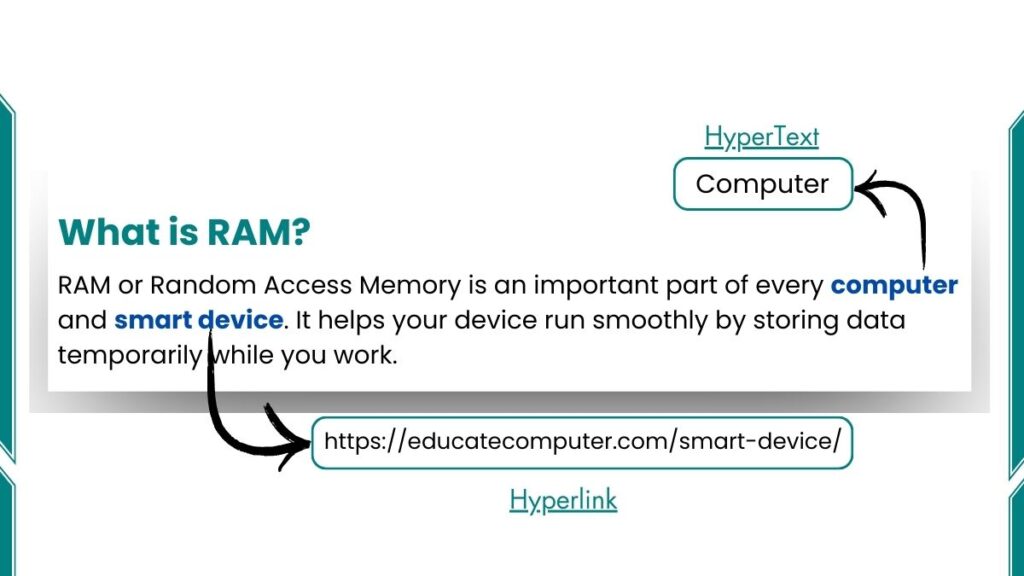Hypertext is a system of linking digital text to other text or multimedia elements through hyperlinks. It allows users to navigate between different pieces of information. Hypertext is a fundamental concept behind the World Wide Web (WWW), where clicking on a link takes you to a different web page, section, or document.

Introduction to Hypertext
Hypertext is a type of text that contains clickable links. These links allow you to jump to other pages, documents, or sections. For example, when you read a Wikipedia article and click on a blue link, you are using hypertext.
Here’s a simple way to understand it:
- A regular book has pages you read one after another.
- Hypertext lets you jump to any page you want in any order.
This makes finding information faster and easier. Instead of reading everything, you can click on links to go directly to the information you need.
History of Hypertext
Hypertext did not always exist. It started as an idea in the 20th century. Let’s look at its history:
- 1945: A scientist named Vannevar Bush imagined a machine called “Memex.” This machine could store and link information. It was like an early version of hypertext.
- 1965: A man named Ted Nelson invented the term “hypertext.” He wanted to create a system where documents could link to each other.
- 1989: Tim Berners-Lee created the World Wide Web. He used hypertext to connect web pages. This is how the internet works today.
Hypertext made the internet what it is now. A giant web of connected information.
How Hypertext Works
Hypertext works by linking pieces of information together. Here’s how it works:
- Nodes: These are the pieces of information, like a webpage or a document.
- Links: These are the clickable connections between nodes.
For example:
- A webpage about “Space” might have a link to “NASA.”
- When you click the link, you go to NASA’s website.
Behind the scenes, hypertext uses HTML (HyperText Markup Language). HTML is the code that creates links. A simple HTML link looks like this:
<a href="https://www.nasa.gov">Visit NASA</a>
- “
a” means “anchor” (a link). hrefis the address the link points to.
When you click a link your browser reads the HTML code and takes you to the new page.
Types of Hypertext
Hypertext can be divided into different types based on how it is structured and how users interact with it.
1. Static Hypertext
Static hypertext consists of links that remain fixed and do not change over time. The connections between different pieces of information are predetermined by the author or creator of the document. Users can navigate through the links, but the content they access remains the same for everyone.
This type of hypertext is commonly found in educational materials, research papers, and online reference sources.
2. Dynamic Hypertext
Dynamic hypertext is more advanced because the links and content change based on user interaction. Unlike static hypertext, where the structure remains fixed. Dynamic hypertext adapts to different users and their specific queries.
A common example of dynamic hypertext is Google Search. When a user enters a search query, Google generates a unique set of search results based on various factors such as relevance, location, and user preferences. The links displayed change dynamically for each person and provide a personalized experience
3. Linear and Non-Linear Hypertext
Linear hypertext follows a fixed sequence. They guide users from one section to the next in a structured manner. This type of hypertext is similar to traditional books or documents, where readers move from one page to another in a set order.
It is commonly used in eBooks, online courses, and step-by-step tutorials. For example, an online programming tutorial might require users to complete lesson one before moving to lesson two.
Non-linear hypertext is beneficial for research and learning because it gives users the freedom to access information in a way that suits them. However, it can sometimes lead to distractions if too many links are available without clear guidance.
Also Read: Examples of Hypertext
Difference Between Hypertext and Hyperlink
Here’s a simple table to help you understand the difference between hypertext and hyperlink.
| Aspect | Hypertext | Hyperlink |
|---|---|---|
| Definition | A system of text that contains clickable links. | A single clickable element that connects two pieces of information. |
| Purpose | To create a network of interconnected information. | To act as a bridge between two nodes (pages, documents, etc.). |
| Example | A webpage with multiple links to other pages. | A blue underlined word or button that you click to go to another page. |
| Scope | Broader (includes all linked content). | Narrower (a single link within hypertext). |
| Structure | Made up of multiple nodes (pages) and links. | A single connection between two nodes. |
| Real-Life Analogy | A book with a table of contents and page numbers. | A single page number that takes you to a specific chapter. |
| Technical Example | A Wikipedia article with links to related topics. | The HTML code: <a href="https://example.com">Click Here</a>. |
| User Interaction | Users can explore multiple paths of information. | Users click to move from one point to another. |
FAQs
Is hypertext only for text?
No! Hypertext can include images, videos, and buttons. For example, clicking a picture can take you to another page.
How is HTML related to hypertext?
HTML is the code used to create hypertext. It tells the computer where to link and how to display the text.
Can hypertext work offline?
Yes! E-books and PDFs use hypertext. You can click links even without the internet.
